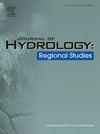Spatiotemporal evolution of droughts and floods in the Yellow River Basin: A novel approach combining CMADS-L evaluation, hydroclimatic zonation and CNN-LSTM prediction
IF 4.7
2区 地球科学
Q1 WATER RESOURCES
引用次数: 0
Abstract
Study Region
Yellow River Basin, China, a region of critical ecological and economic significance.
Study Focus
This research presents a novel integrated framework for regional drought-flood analysis and precipitation forecasting by evaluating CMADS-L and ERA5 reanalysis datasets against ground-based observations in the Yellow River Basin. We implement K-means clustering on Standardized Precipitation Evapotranspiration Index (SPEI) sequences to identify drought-flood regions and validate a CNN-LSTM hybrid model for regional precipitation forecasting, uniquely bridging traditional climate analysis with modern deep learning techniques for enhanced prediction accuracy.
New Hydrological Insights for the Region: Our Analysis Reveals
(1) CMADS demonstrates superior performance over ERA5 in precipitation representation (r = 0.93 vs 0.92; MAE: 9.6 mm vs 17.5 mm; RMSE: 15.8 mm vs 25.9 mm), providing the first comprehensive evaluation of these datasets in complex terrain; (2) We identify three distinct hydroclimatic zones: Northeast (31.6 % area, "wet-dry-wet" sequences, quasi-4.5-year oscillations), Southeast (42.5 %, post-2000 drying trends, quasi-2.3-year cycles), and Western (25.9 %, post-2008 drying, quasi-12-year periodicities); (3) Our novel CNN-LSTM hybrid model achieves unprecedented prediction performance (R²: 0.70–0.85), with highest accuracy in the Western zone due to stable precipitation patterns. This integrated approach significantly advances regional hydroclimate understanding and provides a robust, transferable framework for water resource management under changing climate conditions, offering valuable methodological insights for similar river basins globally.
求助全文
约1分钟内获得全文
求助全文
来源期刊

Journal of Hydrology-Regional Studies
Earth and Planetary Sciences-Earth and Planetary Sciences (miscellaneous)
CiteScore
6.70
自引率
8.50%
发文量
284
审稿时长
60 days
期刊介绍:
Journal of Hydrology: Regional Studies publishes original research papers enhancing the science of hydrology and aiming at region-specific problems, past and future conditions, analysis, review and solutions. The journal particularly welcomes research papers that deliver new insights into region-specific hydrological processes and responses to changing conditions, as well as contributions that incorporate interdisciplinarity and translational science.
 求助内容:
求助内容: 应助结果提醒方式:
应助结果提醒方式:


